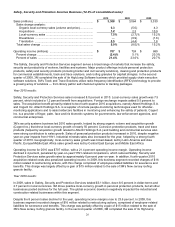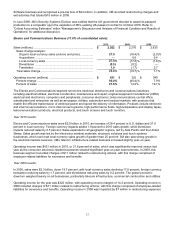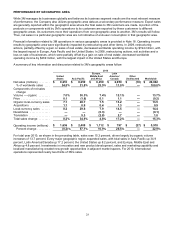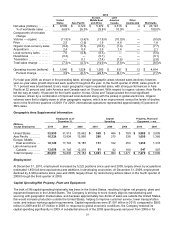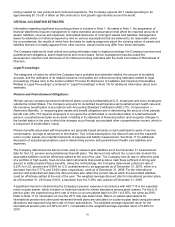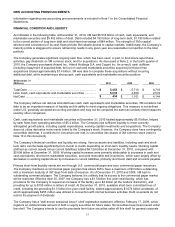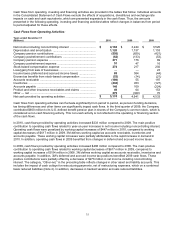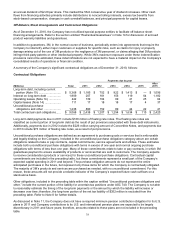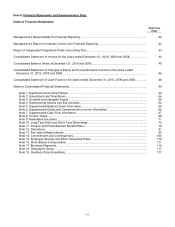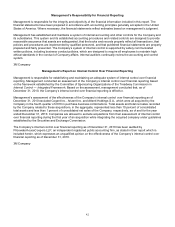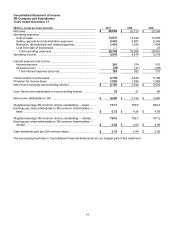3M 2010 Annual Report Download - page 40
Download and view the complete annual report
Please find page 40 of the 2010 3M annual report below. You can navigate through the pages in the report by either clicking on the pages listed below, or by using the keyword search tool below to find specific information within the annual report.34
purposes. In connection with a prior “well-known seasoned issuer” shelf registration, in June 2007 the Company
established a $3 billion medium-term notes program. Three debt securities have been issued under this medium-
term notes program. First, in December 2007, 3M issued a five-year, $500 million, fixed rate note with a coupon rate
of 4.65%. Second, in August 2008, 3M issued a five-year, $850 million, fixed rate note with a coupon rate of 4.375%.
Third, in October 2008, the Company issued a three-year $800 million, fixed rate note with a coupon rate of 4.50%.
The Company entered into an interest rate swap to convert this $800 million note to a floating rate.
The Company has an AA- credit rating, with a stable outlook, from Standard & Poor’s and an Aa2 credit rating, with a
stable outlook, from Moody’s Investors Service. The Company’s $350 million of Dealer Remarketable Securities had
ratings triggers (BBB-/Baa3 or lower) that would require repayment of debt. These securities were retired upon
maturity in December 2010. In addition, under the $1.5-billion five-year credit facility agreement, 3M is required to
maintain its EBITDA to Interest Ratio as of the end of each fiscal quarter at not less than 3.0 to 1. This is calculated
(as defined in the agreement) as the ratio of consolidated total EBITDA for the four consecutive quarters then ended
to total interest expense on all funded debt for the same period. At December 31, 2010, this ratio was approximately
35 to 1.
3M’s cash and cash equivalents balance at December 31, 2010 totaled $3.377 billion, with an additional $1.641
billion in current and long-term marketable securities. 3M’s strong balance sheet and liquidity provide the Company
with significant flexibility to take advantage of numerous opportunities going forward. The Company will continue to
invest in its operations to drive growth, including continual review of acquisition opportunities. 3M paid dividends of
$1.5 billion in 2010, and has a long history of dividend increases. In February 2011, 3M’s Board of Directors
increased the quarterly dividend on 3M common stock by 4.8 percent to 55 cents per share, equivalent to an annual
dividend of $2.20 per share. In February 2011, 3M’s Board of Directors also authorized the repurchase of up to $7.0
billion of 3M’s outstanding common stock, replacing the Company’s existing repurchase program. This authorization
has no pre-established end date.
In 2011, the Company expects to contribute in cash an amount in the range of $400 million to $600 million to its U.S.
and international pension and postretirement plans. The Company does not have a required minimum pension
contribution obligation for its U.S. plans in 2011. Therefore, the amount of the anticipated discretionary contribution
could vary significantly depending on the U.S. qualified plans’ funded status as of the 2011 measurement date and
the anticipated tax deductibility of the contribution. Future contributions will also depend on market conditions,
interest rates and other factors. 3M believes its strong cash flow and balance sheet will allow it to fund future pension
needs without compromising growth opportunities.
The Company uses various working capital measures that place emphasis and focus on certain working capital
assets and liabilities. These measures are not defined under U.S. generally accepted accounting principles and may
not be computed the same as similarly titled measures used by other companies. One of the primary working capital
measures 3M uses is a combined index, which includes accounts receivable, inventory and accounts payable. This
combined index (defined as quarterly net sales — fourth quarter at year-end — multiplied by four, divided by ending
net accounts receivable plus inventory less accounts payable) was 5.3 at December 31, 2010, a decline from 5.5 at
December 31, 2009. Receivables increased $365 million, or 11.2 percent, compared with December 31, 2009, with
higher December 2010 sales compared to December 2009 sales contributing to this increase. In addition,
acquisitions increased accounts receivable by $93 million and currency translation increased accounts receivable by
$82 million, as the U.S. dollar weakened in aggregate against a multitude of currencies. Inventories increased $516
million, or 19.6 percent, compared with December 31, 2009. The inventory increases are partially attributable to the
increase in demand in 2010. In addition, acquisitions increased inventories by $77 million year-on-year, while
currency translation increased inventories by $35 million. Accounts payable increased $209 million compared with
December 31, 2009, with acquisitions accounting for $46 million of this increase and currency translation accounting
for $16 million, with the balance primarily related to improvement in business activity.




